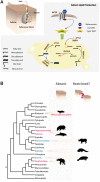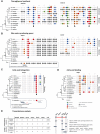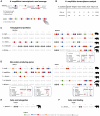Complete Inactivation of Sebum-Producing Genes Parallels the Loss of Sebaceous Glands in Cetacea
- PMID: 30895322
- PMCID: PMC6526905
- DOI: 10.1093/molbev/msz068
Complete Inactivation of Sebum-Producing Genes Parallels the Loss of Sebaceous Glands in Cetacea
Abstract
Genomes are dynamic biological units, with processes of gene duplication and loss triggering evolutionary novelty. The mammalian skin provides a remarkable case study on the occurrence of adaptive morphological innovations. Skin sebaceous glands (SGs), for instance, emerged in the ancestor of mammals serving pivotal roles, such as lubrication, waterproofing, immunity, and thermoregulation, through the secretion of sebum, a complex mixture of various neutral lipids such as triacylglycerol, free fatty acids, wax esters, cholesterol, and squalene. Remarkably, SGs are absent in a few mammalian lineages, including the iconic Cetacea. We investigated the evolution of the key molecular components responsible for skin sebum production: Dgat2l6, Awat1, Awat2, Elovl3, Mogat3, and Fabp9. We show that all analyzed genes have been rendered nonfunctional in Cetacea species (toothed and baleen whales). Transcriptomic analysis, including a novel skin transcriptome from blue whale, supports gene inactivation. The conserved mutational pattern found in most analyzed genes, indicates that pseudogenization events took place prior to the diversification of modern Cetacea lineages. Genome and skin transcriptome analysis of the common hippopotamus highlighted the convergent loss of a subset of sebum-producing genes, notably Awat1 and Mogat3. Partial loss profiles were also detected in non-Cetacea aquatic mammals, such as the Florida manatee, and in terrestrial mammals displaying specialized skin phenotypes such as the African elephant, white rhinoceros and pig. Our findings reveal a unique landscape of "gene vestiges" in the Cetacea sebum-producing compartment, with limited gene loss observed in other mammalian lineages: suggestive of specific adaptations or specializations of skin lipids.
Keywords: comparative genomics; gene loss; marine mammals; skin lipids.
© The Author(s) 2019. Published by Oxford University Press on behalf of the Society for Molecular Biology and Evolution.
Figures




Similar articles
-
Decay of Skin-Specific Gene Modules in Pangolins.J Mol Evol. 2023 Aug;91(4):458-470. doi: 10.1007/s00239-023-10118-z. Epub 2023 May 30. J Mol Evol. 2023. PMID: 37249590 Free PMC article.
-
Evolution of the MC5R gene in placental mammals with evidence for its inactivation in multiple lineages that lack sebaceous glands.Mol Phylogenet Evol. 2018 Mar;120:364-374. doi: 10.1016/j.ympev.2017.12.010. Epub 2017 Dec 19. Mol Phylogenet Evol. 2018. PMID: 29277542
-
Suppression of sebum secretion with 13-cis-retinoic acid: effect on individual skin surface lipids and implications for their anatomic origin.J Invest Dermatol. 1984 Jan;82(1):74-8. doi: 10.1111/1523-1747.ep12259161. J Invest Dermatol. 1984. PMID: 6228612 Clinical Trial.
-
Sebaceous gland lipids.Semin Dermatol. 1992 Jun;11(2):100-5. Semin Dermatol. 1992. PMID: 1498012 Review.
-
On the revolution of cetacean evolution.Mar Genomics. 2018 Oct;41:1-5. doi: 10.1016/j.margen.2018.08.004. Epub 2018 Aug 25. Mar Genomics. 2018. PMID: 30154054 Review.
Cited by
-
The Acari Hypothesis, VI: human sebum and the cutaneous microbiome in allergy and in lipid homeostasis.Front Allergy. 2024 Nov 21;5:1478279. doi: 10.3389/falgy.2024.1478279. eCollection 2024. Front Allergy. 2024. PMID: 39640432 Free PMC article.
-
Gene losses may contribute to subterranean adaptations in naked mole-rat and blind mole-rat.BMC Biol. 2022 Feb 17;20(1):44. doi: 10.1186/s12915-022-01243-0. BMC Biol. 2022. PMID: 35172813 Free PMC article.
-
Cetacean epidermal specialization: A review.Anat Histol Embryol. 2022 Sep;51(5):563-575. doi: 10.1111/ahe.12829. Epub 2022 Jun 27. Anat Histol Embryol. 2022. PMID: 35758554 Free PMC article. Review.
-
Transcriptome Analysis Reveals Anti-inflammatory, Antiapoptotic, and Milk Synthesis-Promoting Effects of Lithium Chloride in Bovine Mammary Epithelial Cells.Biol Trace Elem Res. 2025 Apr 11. doi: 10.1007/s12011-025-04614-0. Online ahead of print. Biol Trace Elem Res. 2025. PMID: 40214951
-
The genome of African manatee Trichechus senegalensis reveals secondary adaptation to the aquatic environment.iScience. 2024 Jun 28;27(7):110394. doi: 10.1016/j.isci.2024.110394. eCollection 2024 Jul 19. iScience. 2024. PMID: 39092175 Free PMC article.
References
Publication types
MeSH terms
Substances
LinkOut - more resources
Full Text Sources

